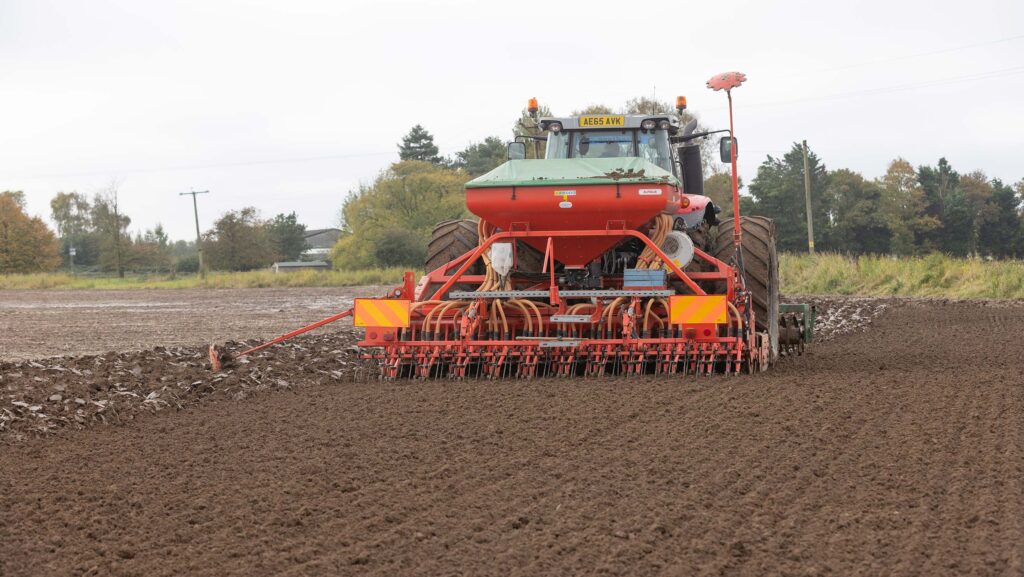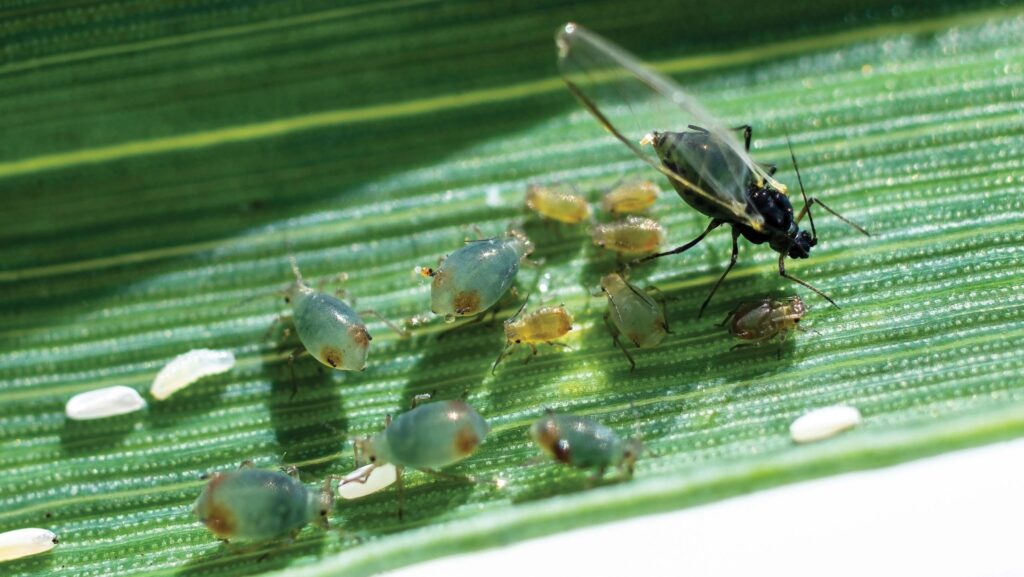Crop Watch: BYDV aphid threat and rain hit maize harvest
 © GNP
© GNP With a more settled spell of weather, slowly but surely, more acres of winter wheat are going into the ground. Bean drilling has kicked off in the east.
The warm conditions have increased the barley yellow dwarf virus threat from aphids.
Farmers are being advised to check established winter cereal crops, and aphicides are already planned for some in the East over the coming days.
See also: How farmers can benefit from growing hemp market
North
Chris Leslie – New writer
AICC/Cloud Farming Groundswell (central and southern Scotland)
It’s easy to say it’s been a tough season and throw out the usual excuses – I’m getting good at those.
Some of them even ring true, like “good crops promote good crops the following year” or “bare patches will need remedial work”.
And one that’s always worth remembering, “well sown is half grown”, which pretty much means making sure the seed-bed is fit, no matter the drilling technique you’re using.
Overall, the 2025 crops are off to a decent start.
The early sowings did have a few challenges with cloddy seed-beds and moisture retention, especially after the rain delays hit in September and held up both harvest and sowing operations.
The rain put to bed any hopes of getting oilseed rape in the ground that month.
I’ve been saying “don’t sow small seeds in a month with an R in it” quite a bit – it’s been the answer to a lot of questions about establishing grass, OSR and cover crops.
Thankfully, cabbage stem flea beetle hasn’t been as much of an issue this year. Maybe it doesn’t enjoy a cool Scottish summer, much like shorts haven’t made many appearances this season.
But while flea beetles been quieter, slugs have taken the stage. We’re seeing slug eggs at the roots of most bean and OSR crops, so a slug explosion seems imminent – pellets at the ready.
Some interesting products have come to light, though, like the sea-to-soil fish hydrolysate trialled by Niab TAG.
It seems to have a response on flea beetle, and possibly slugs, too. And judging by the smell, I can see why.
Wheat
Winter wheat, sown the first Monday after the first Sunday in September, is looking strong for those who cleared their fields in time.
Shallow cultivating the previous OSR stubbles early to cut down on flea beetle seems to be catching on around here, and it might’ve helped lower slug pressure as well.
Pre-emergence applications have been doing a solid job on weed control, so we likely won’t need many post-emergence touch-ups.
There’s still some autumn sowing left to tackle after the potatoes, which are running late due to their small size. These crops will need an increased seed rate to offset what’s likely coming.
Some of the earlier potato fields unfortunately caught the tail end of those September rains, which ranged from 18mm up to a soggy 63mm – the latter leaving a few patches struggling to establish.
Now, we’re gearing up for Kerb (propyzamide) applications on OSR as soil temperatures start to cool down.
Meeting season is about to kick off.
I’m possibly looking forward the most to our time with the Nutri-Tech group and lucky enough to be in the company of Sarah Kendall and Roger Sylvester-Bradley, both from Adas, to look over all our data from last season as we now realise the importance of tissue and grain analysis to finish off the season’s learnings.
South
Justin Smith
Procam (East Sussex)
It never ceases to amaze me how much growers achieve when a small weather window finally appears.
When four such days presented themselves at the start of October, the countryside was awash with drills and horsepower.
Steady progress was made, a fair bit using the plough, but with surprisingly good results. To those continuing to battle against the elements, I wish you the very best of luck.
I also appreciate, with the best of intentions, that some of this ground will now be better off left until spring.
However, if a good seed-bed can be produced, I will continue to back winter wheat drilling well into late November. The key here being attention to detail.
Pre-emergence herbicides will generally form the backbone of the most cost-effective weed control options.
Nonetheless, the seed-beds and conditions must be right for effective use; I urge farmers to resist the temptation to maul crops in.
Herbicide approach
If the seed-beds and conditions have allowed, my first-choice active ingredient for blackgrass and ryegrass control in winter wheat has been cinmethylin (Luxinum Plus), with the tank mix partner very much dependant on the further grass and broad-leaved weed pressures present.
For example, Tower (chlorotoluron + diflufenican + pendimethalin) provides some useful actives for further grassweed control, but also brings in activity on tricky broad-leaved weeds such as groundsel.
Alternatively, in less demanding situations straight or co-formulated options of diflufenican, picolinafen and pendimethalin can offer some useful herbicide additions at a slightly cheaper cost.
In winter barley grassweed situations, I have opted for Cadou Met (flufenacet + diflufenican + metribuzin) as a starter alongside either Tower or Avadex Factor (tri-allate), depending on whether brome, wild or tame oats are present.
The aim is to stack as many actives as possible early in the programme, in the absence of many post-emergence or spring-based alternatives.
Slugs continue to be present on all crops and winter oilseed rape continues to be prove tricky, with uneven establishment, pests and weeds all taking their toll.
Despite all these challenges, I continue to focus on the things I have control over and try to not let the others negatively impact me too much. I remain hopeful.
East
Ryan Baker
Frontier (Suffolk/Norfolk)
Breaks in the showers have allowed drilling to progress on all soil types; the majority of winter barley was in the ground by the third week of October.
Thoughts have now turned to top-up herbicides.
On wheat fields with the most challenging blackgrass and ryegrass, aclonifen is now being followed up at early post emergence with cinmethylin.
This will give us the opportunity to apply the best diversity of active ingredients at the most appropriate rates and within approved label timings.
On more moderate populations, a peri-emergence application of flufenacet will give additional control.
At this timing, metribuzin can bring some additional contact activity on already emerged grassweeds as well as additive activity on broad-leaved weeds such as groundsel.
Aphids are easily found in the milder and more settled breaks in the weather. T-sum-170, the accumulation of 170 day degrees above a threshold of 3C from crop emergence, will be reached quickly and indicates the likely arrival of the second generation which will spread the virus.
This is the time to check for the presence of aphids in your cereal crops.
Yield loss can be up to 50% although barley is associated with higher losses than wheat.
Bean drilling
Drilling of winter beans has started. Propyzamide will form the backbone of the control of blackgrass. I will be trying some aclonifen in beans this year to see how it performs.
It is stronger on volunteer oilseed rape, pansy and cranesbill, whereas Nirvana (imazamox + pendimethalin) has better activity on knotgrass, black bindweed and fumitory.
For those with a particular cleavers issue, clomazone is an effective addition to the mix.
Warm and mild conditions have been conducive to the presence of phoma in OSR. It will be important to carefully monitor varieties with a resistance rating of seven or below.
Prothioconazole and azoxystrobin both have good activity.
Azoles such as tebuconazole and metconazole also have growth regulation activity.
For the most forward crops, an element of growth regulation will improve stem collar thickness and rooting, and reduce excess autumn growth.
Although we have the soil moisture required for the application of propyzamide to oilseed rape, soil temperatures are not yet there.
As we get further into the autumn, continue to monitor and once soil temperatures reach 10C and falling, applications can commence.
Weed burden will dictate whether to use Kerb Flo (propyzamide) plus Belkar (halauxifen + picloram) or Astrokerb (aminopyralid + propyzamide).

Bird cherry oat aphid © Blackthorn Arable
West
Dominic Edmond
Matford Arable (Devon/Cornwall)
At the time of my last Crop Watch report, along with everyone else I was hoping for a couple of weeks of good weather to make progress on the maize harvest and the autumn drilling.
It seems someone was listening, as we can now expect what looks like at least 10 days of relatively good weather. Sighs of relief all round.
Maize harvest has continued in the past few weeks in between the outbreaks of rain, with crops still yielding pretty well for the year.
Unfortunately, one of the storms a few weekends back decided to add some high winds to the mix which caused a number of crops to lodge (particularly the later-drilled crops in the spring).
This has made harvest even more tricky and the plough is the only way to hide a lot of the material that has been left.
Drilling has been a stop-start affair, but slowly, more acres have gone in the ground.
Some of the crops that were drilled several weeks ago have emerged, albeit with some patches in the field where seed has rotted. Spraying has also been sporadic.
Winter barley
Large acreages of winter barley have emerged with no pre-emergence applied and as yet no aphicide, so many of these will receive their application over the next 10 days.
With aphid counts (particularly the bird cherry aphid) revealing high numbers – and evidence in the field that this is the case – the aphicide can’t go on quick enough.
If the good weather being promised materialises then any winter barley drilled in the next week or so will receive a pre-emergence herbicide.
The old adage “if it’s dry enough to drill its dry enough to spray” is making a lot of sense, as one cannot necessarily rely on getting the post-emergence application on the crop if the weather turns.
Slug pressure has increased in the past few weeks, with some damage in establishing cereal and grass crops.
Cereals are particularly suffering where they follow OSR crops, or where the seed-bed is a bit cloddy or has any trash on the surface.
Ever the optimist, by my next Crop Watch report I’m confident that all maize crops will be harvested and autumn drilling of crops completed, along with autumn spraying too. Just don’t ask me to put any money on it.

